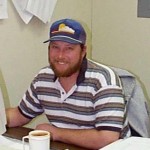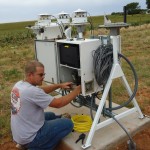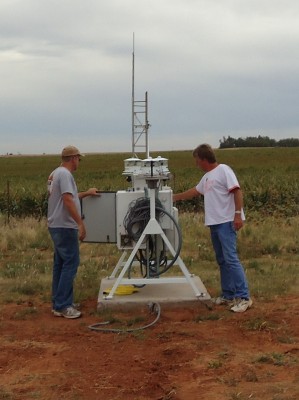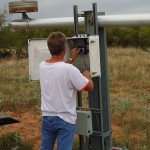 A few years ago, ARM made the decision to shrink the footprint of the Southern Great Plains (SGP) site to more closely replicate the size of a climate model grid cell (150 x 150 kilometers). This led to a strategy for relocating many of the outlying instrument clusters to new locations within the smaller domain. This would result in a denser network of measurements at the new extended facilities (EFs).
A few years ago, ARM made the decision to shrink the footprint of the Southern Great Plains (SGP) site to more closely replicate the size of a climate model grid cell (150 x 150 kilometers). This led to a strategy for relocating many of the outlying instrument clusters to new locations within the smaller domain. This would result in a denser network of measurements at the new extended facilities (EFs).
On the heels of this decision came the windfall of new instruments and upgrades from the Recovery Act. To say that site operations folks have been a little busy would be an understatement!
Between negotiating new leases with landowners, securing the locations for the new instruments, and prepping the extended facility sites with new groundwork, infrastructure, and remote data systems, there has been nary a dull moment. David Breedlove, head of SGP instrument maintenance, fills us in on life in the fast lane at SGP—from dirt roads between farms to satellite links in the sky.
What was the first thing you had to tackle when the site transition plan became a reality?
 The first task prior to instrument installation was to build the upgraded solar radiometer stands. Resembling a sawhorse, these metal stands allowed greater stability, easier installation, reduced cable and underground conduit, and more efficient maintenance. They also allowed for an independent UPS power source and better power distribution to the instruments located on the stand.
The first task prior to instrument installation was to build the upgraded solar radiometer stands. Resembling a sawhorse, these metal stands allowed greater stability, easier installation, reduced cable and underground conduit, and more efficient maintenance. They also allowed for an independent UPS power source and better power distribution to the instruments located on the stand.
Cleaning, assembling, and testing the instruments that had been removed from the field the previous fall also consumed numerous working hours. Many of the instruments had been in the field for more than a decade, and much of the small hardware had rusted and required replacement. New wireless modems for internal site communications were also added to each instrument control box. This all had to be assembled and tested at the Central Facility prior to deployment.
Who are the key folks involved in the relocation and what are their roles?

Chris and James Martin are the primary technicians in this entire effort for the instrument maintenance department. They removed the instruments from the field last fall, assembled the new stands, calibrated sensors, helped implement the new wireless modems, and tested the instruments at the Central Facility.
In one 5-week period, they installed 7 instruments at 8 new sites. This included assembling and installing all instrument stands, frames, and towers, pulling data cables through underground conduits, labeling wires and installing connectors, connecting power to the UPS power box and instruments, installing all sensors and connecting them to their respective data loggers, editing programs with the new site parameters (latitude/longitude/elevation, site name, sensor calibration factors), loading the new programs and testing all the sensors, making repairs or replacing failed sensors, leveling, aligning, and adjusting shading for all solar sensors and trackers, and recording serial numbers for inventory tracking.
What are some of the biggest challenges you’ve come across?
Coordinating personnel to support the installation schedule and continue to maintain our normal set of instrumentation. This was tricky at times as mentors were also requesting personnel to perform new instrument testing, upgrades, and support for field campaigns that were ongoing during some of this period. Not to mention that Chris is the primary tech on the Raman lidar, and it was suffering some technical issues from its recent upgrades.
How do you keep your sense of humor?
Well, “pressure” is my middle name, and impossible missions are our specialty. It helps to have a great crew with mad skills that don’t know the word “quit.”
What has been keeping you up at night, besides the heat?
After a short breather and cold beverage, we have to start removing more instruments from sites scheduled to be decommissioned for the SGP footprint reduction and conduct training on the new extended facilities computer collection system.
Who or what is the best kept secret at the SGP site?
 I’m not sure how much of a secret it is, but our field maintenance crew is a formidable weapon. They have a combined 76 years of experience working at the site. Over the last 19 years, we have seen it all, meteorologically and scientifically speaking. From lasers to radars to aircraft to satellites, they have worked on or with instrumentation and scientist from around the globe. Scientists dream them up, we keep them running. Through wind and rain, snow and ice, day or night, they do whatever is necessary to advance the science.
I’m not sure how much of a secret it is, but our field maintenance crew is a formidable weapon. They have a combined 76 years of experience working at the site. Over the last 19 years, we have seen it all, meteorologically and scientifically speaking. From lasers to radars to aircraft to satellites, they have worked on or with instrumentation and scientist from around the globe. Scientists dream them up, we keep them running. Through wind and rain, snow and ice, day or night, they do whatever is necessary to advance the science.

